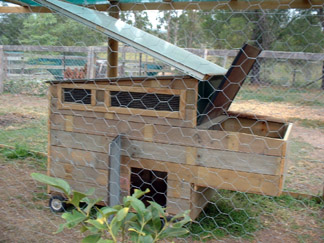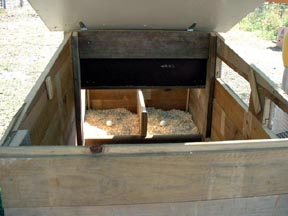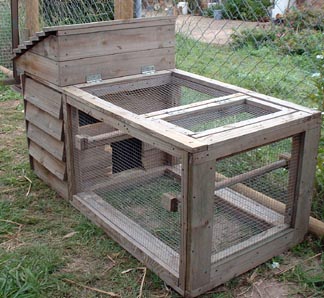|

The wheels are all from discarded lawnmower bodies, again just simply unbolted from the frames of "dead" mowers in the tip. They have been sprayed and dipped in a natural pyrethum mix.
The average price of a new wheel is $10 each. cost here..ZERO
All we simply do is roll them from coop module to coop module on their own lawnmower wheels.

Above is a sneak peak at the interior with some fresh bright white Campine eggs in the layer boxes. 
Hen & Chicken Nursery Suites: This little house is made from the same treated pine shiplap, and is designed to move around the garden with ease. I have to add the little mower wheels to move them easier.
I now have 4 of these that are used raising chickens naturally. They are fully wired, and in the main floor as well. The roof section is insulated with foam, and opens up for easy access into the main house for cleaning.
How to make an ugly dead Eucalyptus Stump not look so ugly. 
Above and below is a huge stump from a eucalyptus tree. After treating it for whiteants, we let it sit for 4 weeks, then we added a garden border to it, and filled either side with shellgrit and oyster shells. The birds love it. and it adds a small feature to the overall coop.
Shellgrit is essential for the development of strong eggshells. 
|  |
|
Layer boxes: I simply use recycled 20 litre plastic water or detergent drums. I cut the end out of them and line them with a combination of pine shavings and shell grit.
Malathion Insecticide: This is a vicious chemical used to eradicate any bugs, mites, lice, etc, that hide in the untreated timber sections. I dont like using chemicals, but I find that if I do this 3 times a year, I have very little bug problems. Use very sparingly and with caution.
Neem Tree: Planted to eradicate bugs naturally, and it makes a great place for the chickens to relax under.
Other Herbs used: We grow wormwood, mugwort, comfrey and chillies and have small citrus all in the chicken areas, We find that these herbs combined with the Neem Tree seem to give us very few problems with insect and intestinal predators, however we do use a wormer in the water feeders as well.
Sunflowers: Easy to grow and transplant into the chicken areas, and are a great natural snack for the chickens.
Tea Tree Oil: An amazing natural Aussie product that is a good natural deterent for mites,lice, etc and used in a little spray bottle at about a ratio of 10 to 1 (with water) on any of the wooden areas and perches.
Good for spraying on the dogs for fleas, as well.
It's active ingredient is the extracted oils of the Melaleuca Alternifolia or commom Aussie tea tree.
It's also great for minor cuts and infections in humans and animals. We use a locally made brand from Byron Bay, NSW. Australia
|
|


